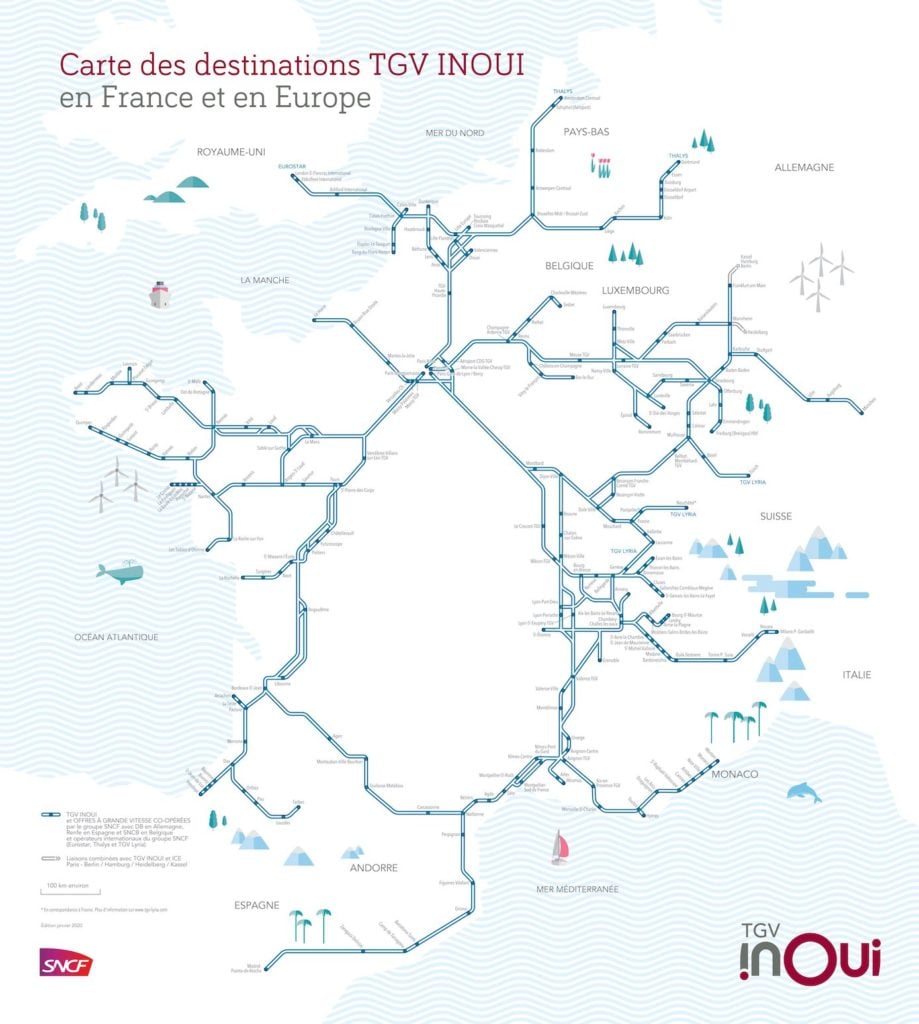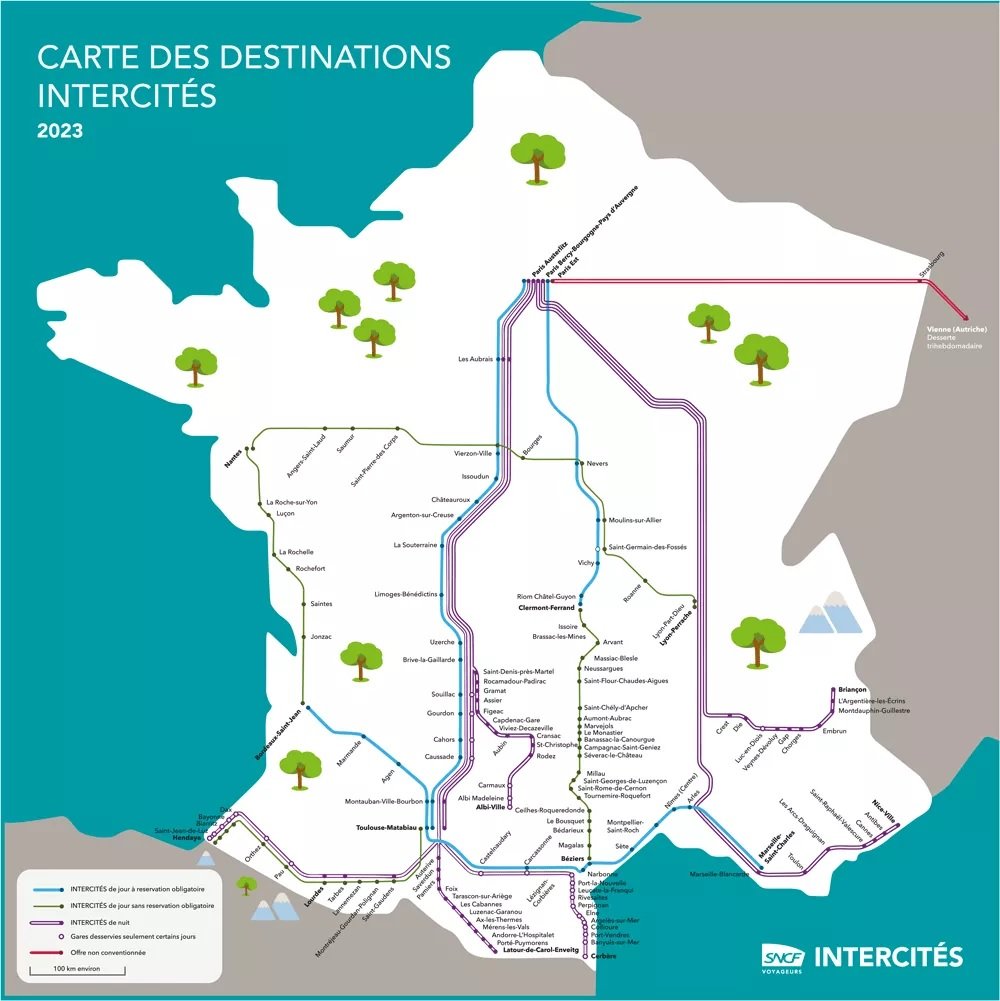MAP: Where high-speed trains can take you in France

With approaching 3,000 kilometres of high-speed line, France has the second-longest high-speed rail network in Europe - here's where you can go by high-speed TGV trains.
The fastest lines connect some 200 cities across France and more routes being improved or under construction - and that's before we get onto the international connections.
France has the fourth biggest high-speed rail network in the world and the second biggest in Europe (behind Spain).
READ ALSO VIDEO: France unveils its next-generation high-speed TGV trains
France's state-run rail operator SNCF operates two types of the high-speed TGV trains: the TGV InOui, and the low-cost option, Ouigo. Both of these run on the high-speed lines and connect cities and bigger towns, but the cheaper Ouigo trains are slightly more basic, with less storage space and no buffet car or onboard wifi.
Meanwhile competitors from other European rail operators also offer services within and out of French borders to 30 European cities including London, Turin, Brussels, Geneva and many more.
Trains on the high-speed network will take you between France’s major cities in just a few hours, travelling at speeds of up to 320km/h.
Paris to Marseille, for example, takes just three hours to travel 770km; while travellers can reach Lyon (460km), Nantes (381km) or Bordeaux (581km) from the capital in about two hours.
READ ALSO Yes, train travel across Europe is far better than flying - even with kids
That means it compares favourably to high-speed rail in the UK, for example where the fastest train from London to Aberdeen - roughly the same distance as Paris to Bordeaux - will take over seven hours, and will often cost a lot more.
You can find a full list of all the routes on this network on the SNCF Connect website.
The first French high-speed railway, the LGV Sud-Est, opened in 1981. It was also Europe’s first high-speed rail line, and linked Paris and Lyon.
While you can zip easily between Paris and the Atlantic coast, or the Mediterranean, or down the eastern side of the country to the ski resorts in the Alps, a large part of the country remains unconnected to the high-speed network, as the map shows.
You can also download the higher resolution pdf version here.

Image: SNCF Connect
Services - especially international services - tend to be focused on Paris, which means that the rail network is often more practical for those in the capital to use.
Beyond TGVs - and less well known - France’s Intercités services run on the country’s main rail lines. They are slower, travelling at a top speed of 160km/h to some 135 destinations the length and breadth of the country. But if you’re in less of a rush, they may be worth your while.

Image: SNCF Intercites
The daytime Intercités network has seven lines:
Paris – Clermont-Ferrand
Paris – Orléans – Limoges – Toulouse
Bordeaux – Toulouse – Marseille
Béziers – Clermont-Ferrand
Nantes – Bordeaux
Nantes – Lyon
Toulouse – Hendaye
Departing from Paris-Austerlitz, overnight Intercités take the gentle route to Toulouse, Rodez, Latour-de-Carol, Cerbère, Lourdes, Briançon and Nice. A service to Aurillac is expected to start in December 2023.
READ ALSO 8 French night trains to take this summer
Tickets start at €15 one-way, with prices depending on departure dates. Nevertheless, Intercités tickets generally cost less than TGVs, not least because they are partly subsidised by the State.
READ ALSO How to save money travelling by train in France
Regional trains, meanwhile, take up the slack of shorter local travel, including daily commutes.
Comments (1)
See Also
The fastest lines connect some 200 cities across France and more routes being improved or under construction - and that's before we get onto the international connections.
France has the fourth biggest high-speed rail network in the world and the second biggest in Europe (behind Spain).
READ ALSO VIDEO: France unveils its next-generation high-speed TGV trains
France's state-run rail operator SNCF operates two types of the high-speed TGV trains: the TGV InOui, and the low-cost option, Ouigo. Both of these run on the high-speed lines and connect cities and bigger towns, but the cheaper Ouigo trains are slightly more basic, with less storage space and no buffet car or onboard wifi.
Meanwhile competitors from other European rail operators also offer services within and out of French borders to 30 European cities including London, Turin, Brussels, Geneva and many more.
Trains on the high-speed network will take you between France’s major cities in just a few hours, travelling at speeds of up to 320km/h.
Paris to Marseille, for example, takes just three hours to travel 770km; while travellers can reach Lyon (460km), Nantes (381km) or Bordeaux (581km) from the capital in about two hours.
READ ALSO Yes, train travel across Europe is far better than flying - even with kids
That means it compares favourably to high-speed rail in the UK, for example where the fastest train from London to Aberdeen - roughly the same distance as Paris to Bordeaux - will take over seven hours, and will often cost a lot more.
You can find a full list of all the routes on this network on the SNCF Connect website.
The first French high-speed railway, the LGV Sud-Est, opened in 1981. It was also Europe’s first high-speed rail line, and linked Paris and Lyon.
While you can zip easily between Paris and the Atlantic coast, or the Mediterranean, or down the eastern side of the country to the ski resorts in the Alps, a large part of the country remains unconnected to the high-speed network, as the map shows.
You can also download the higher resolution pdf version here.

Services - especially international services - tend to be focused on Paris, which means that the rail network is often more practical for those in the capital to use.
Beyond TGVs - and less well known - France’s Intercités services run on the country’s main rail lines. They are slower, travelling at a top speed of 160km/h to some 135 destinations the length and breadth of the country. But if you’re in less of a rush, they may be worth your while.

The daytime Intercités network has seven lines:
Paris – Clermont-Ferrand
Paris – Orléans – Limoges – Toulouse
Bordeaux – Toulouse – Marseille
Béziers – Clermont-Ferrand
Nantes – Bordeaux
Nantes – Lyon
Toulouse – Hendaye
Departing from Paris-Austerlitz, overnight Intercités take the gentle route to Toulouse, Rodez, Latour-de-Carol, Cerbère, Lourdes, Briançon and Nice. A service to Aurillac is expected to start in December 2023.
READ ALSO 8 French night trains to take this summer
Tickets start at €15 one-way, with prices depending on departure dates. Nevertheless, Intercités tickets generally cost less than TGVs, not least because they are partly subsidised by the State.
READ ALSO How to save money travelling by train in France
Regional trains, meanwhile, take up the slack of shorter local travel, including daily commutes.
Join the conversation in our comments section below. Share your own views and experience and if you have a question or suggestion for our journalists then email us at [email protected].
Please keep comments civil, constructive and on topic – and make sure to read our terms of use before getting involved.
Please log in here to leave a comment.